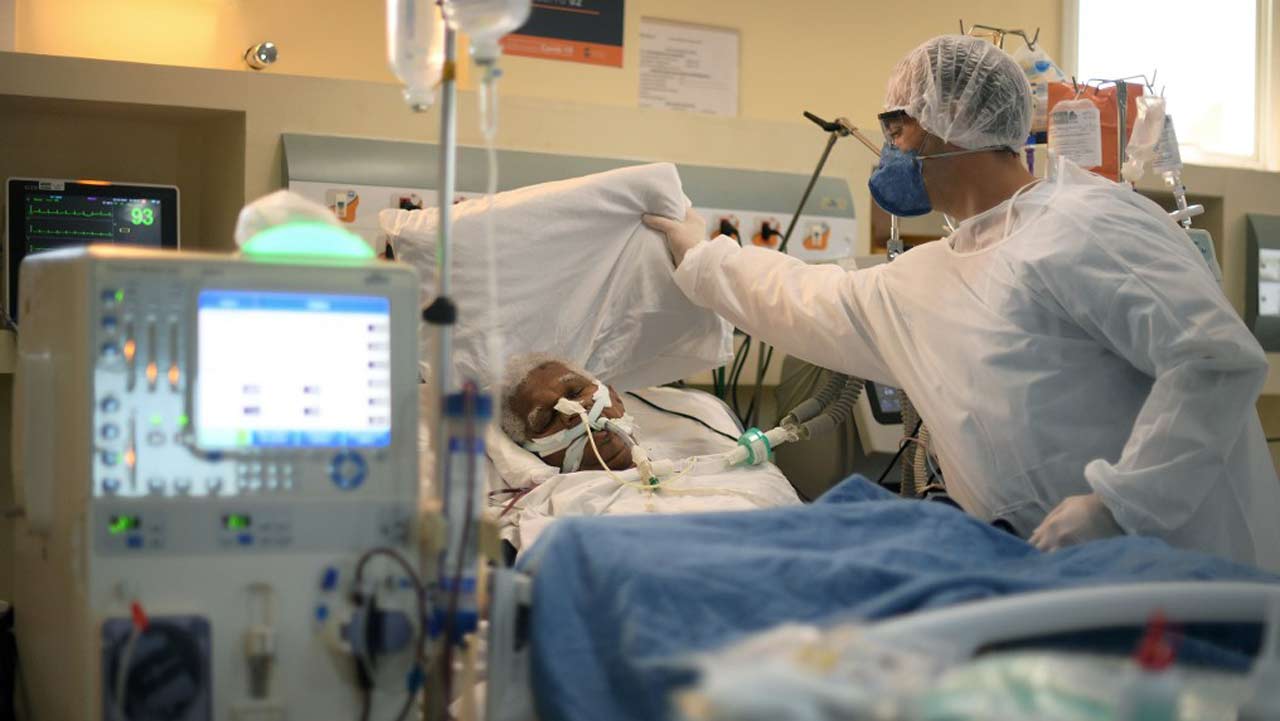The El Niño which caused havoc to the world’s weather in 2016 may be responsible for the severity of this year’s deadly plague outbreak in Madagascar. Experts believe the natural phenomenon dubbed ‘Godzilla’ triggered an increase in rat populations in rural areas, sparking the beginning of the epidemic which has so far infected at least 1,300 people. Forest fires have also driven the rats and their plague-carrying fleas towards areas inhabited by humans, local reports state as a reason behind the surge in cases recorded this year.
But Professor Matthew Bayliss, from Liverpool University’s Institute of Infection and Global Health, suggested floods and heavy rains – triggered by Cyclone Enawo, may also be to blame.
Concerned officials have also warned an ancient ritual, called Famadihana, where relatives dig up the corpses of their loved ones, may also be fueling the spread. Some 600 cases of plague are reported each year in Madagascar, but this year's outbreak has struck early is set to last another six months, as some are worried it will continue to pick up speed. Two thirds of the cases are suspected to be pneumonic plague - described as the 'deadliest and most rapid form of plague'. It is spread through coughing, sneezing or spitting and can kill within 24 hours. It has been reported that 50 aid workers are among those infected.
If bubonic plague – which is transmitted by flea bites - is left untreated, it can turn into pneumonic. So far 93 official deaths have been recorded, but UN estimates the toll may be as high as 124, which has prompted warnings in nine nearby countries - South Africa, Seychelles, La Reunion, Mozambique, Tanzania, Kenya, Ethiopia, Comoros and Mauritius.
Fears have been raised that the plague epidemic could spread through air travel and sea trade. However, experts stress the risk of this is low because of the screening protocols that have been implemented to curb the outbreak.
WHAT IS EL NINO?
El Niño, along with its little sister La Niña, are part of a recurring shift in climate that occurs as warm water shifts from one side of the Pacific to the other. It is caused by a shift in the distribution of warm water in the Pacific Ocean around the equator. Usually the wind blows strongly from east to west, due to the rotation of the Earth, causing water to pile up in the western part of the Pacific. This pulls up colder water from the deep ocean in the eastern Pacific.
However, in an El Niño, the winds pushing the water get weaker and cause the warmer water to shift back towards the east. This causes the eastern Pacific to get warmer. But as the ocean temperature is linked to the wind currents, this causes the winds to grow weaker still and so the ocean grows warmer, meaning the El Niño grows. This change in air and ocean currents around the equator can have a major impact on the weather patterns around the globe by creating pressure anomalies in the atmosphere.
Speaking exclusively to MailOnline, Professor Bayliss warned the particularly aggressive El Niño of 2016 may be behind the aggressive start of this year’s outbreak, which has seen it hit two heavily populated cities for the first time, including the capital Antananarivo.
‘2016 was the strongest El Niño on record, and was nicknamed by some “Godzilla”,’ he said. Some have suggested the growing burden of climate change was to blame. ‘It is a change to the movements of water in the Pacific Ocean which then has an effect on climate in many parts of the world, including east and southern Africa. Our own research suggests that El Niño played a role of the Zika outbreak, but it is also possible that the conditions have facilitated this large scale plague outbreak.’
Professor Bayliss, alongside colleagues including climatologist Dr Cyril Caminade, were behind a 2014 study that found outbreaks of plague in Madagascar are linked to the naturally occurring climate event in the tropical Pacific Ocean.
Published in the Proceedings of the National Academy of Sciences, they found large outbreaks tend to coincide with the fluctuation of air pressure and sea surface temperature, partly driven by El Niño. It was based on data from the previous 48 years.
They were also behind another study, released in the same journal in December last year, which found El Niño fuelled the Zika outbreak in South America. It went on to strike more than 70 countries and caused a surge in the number of babies born with abnormally small heads. The plague outbreak in Madagascar tends to begin in September and ends in April. Tarik Jašarević of the World Health Organization confirmed it would be no different this year.
He said: 'After concerted efforts of the Ministry of Health and partners, we are beginning to see a decline in reported cases but there are still people being admitted to hospital.
AID WORKER ON THE GROUND REVEALS SCALE OF THE PROBLEM
A senior aid worker on the ground in Madagascar has provided MailOnline with an exclusive snapshot of what is happening on the island.
Panu Saaristo, the International Federation of Red Cross' team leader, has revealed thousands of infected adults are unwilling to seek help because they are scared of hospitals. Mr Saaristo said the cultural stigma associated with seeking medical help was masking the true scale of the problem as it means many of those who are infected are failing to be diagnosed. At the same time there is also a growing shortage of life-saving tests which can provide a rapid diagnosis.
Speaking about the decline in plague cases reported today by Madagascan health officials, Mr Saaristo said he feared this is not really the case and that the true scale of the problem growing. He told MailOnline: 'No-one is happier than us, if that is indeed the case'.
'Fear of the fact if they get diagnosed with the infection and the long time they would have to spend in hospital' could be a factor in many not seeking treatment because they connect 'hospitals to death', he added. 'People start avoiding healthcare that may lead to a situation where people start dying.' He warned this year's outbreak has been 'truly unprecedented', and is 'not the plague as usual'.
Figures show that at least 1,300 cases of the plague have been reported so far in this year's outbreak, with 93 official deaths recorded. However, UN estimates state the toll could be in excess of 120. Mr Saaristo warned more deaths are expected unless the urgent shortage of rapid diagnostic tests is immediately addressed, as the majority of plague cases spreading through Madagascar can prove fatal in just 24 hours.
'At this time we cannot say with certainty that the epidemic has subsided. We are about three months into the epidemic season, which goes on until April 2018. Even if the recent declining trend is confirmed, we cannot rule out the possibility of further spikes in transmission between now and April 2018.'
This outbreak is the first time the disease has affected the Indian Ocean island's two biggest cities, Antananarivo and Toamasina, officials said. However, amid widespread fears it could reach Europe, the WHO has stressed the overall global risk of an epidemic is low.
A WHO official added: 'The risk of the disease spreading is high at national level… because it is present in several towns and this is just the start of the outbreak.' International agencies have so far sent more than one million doses of antibiotics to Madagascar. Nearly 20,000 respiratory masks have also been donated. However, the WHO advises against travel or trade restrictions. It has previously asked for $5.5 million (£4.2m) to support the plague response.
Despite its guidance, Air Seychelles, one of Madagascar's biggest airlines, stopped flying temporarily earlier in the month to try and curb the spread. Schools and universities have been shut in a desperate attempt to contain the respiratory disease, with children known to come into contact with each other more than adults, and the buildings have been sprayed to eradicate any fleas that may carry the plague. The first death this year occurred on August 28 when a passenger died in a public taxi en route to a town on the east coast. Two others who came into contact with the passenger also died. Experts have long observed that plague season coincides with the period when Famadihana ceremonies are held from July to October. Willy Randriamarotia, the Madagascan health ministry's chief of staff, said: 'If a person dies of pneumonic plague and is then interred in a tomb that is subsequently opened for a Famadihana, the bacteria can still be transmitted and contaminate whoever handles the body.'
HOW DID THIS YEAR'S OUTBREAK BEGIN?
Health officials are unsure how this year’s outbreak began.
However, some believe it could be caused by the bubonic plague, which is endemic in the remote highlands of Madagascar. If left untreated, it can lead to the pneumonic form, which is responsible for two thirds of the cases recorded so far in this year's outbreak. Rats carry the Yersinia pestis bacteria that causes the plague, which is then passed onto their fleas. Forest fires drive rats towards rural communities, which means residents are at risk of being bitten and infected. Local media reports suggest there has been an increase in the number of blazes in the woodlands.
Without antibiotics, the bubonic strain can spread to the lungs - where it becomes the more virulent pneumonic form. Pneumonic, which can kill within 24 hours, can then be passed on through coughing, sneezing or spitting. However, it can also be treated with antibiotics if caught in time.
Madagascar sees regular outbreaks of plague, which tend to start in September, with around 600 cases being reported each year on the island. However, this year's outbreak has seen it reach the Indian Ocean island's two biggest cities, Antananarivo and Toamasina. Experts warn the disease spreads quicker in heavily populated areas. To limit the danger of Famadihana, rules enforced at the beginning of the outbreak dictate plague victims cannot be buried in a tomb that can be reopened.
Source: Dailymail
ABUJA: Training Schedule for Basic Life Support BLS, Pediatric Advanced Life Support (PALS), Advanced Cardiovascular Life Support ACLS, First Aid, CPR, AED
PORTHARCOURT: Training Schedule for Basic Life Support BLS, Pediatric Advanced Life Support (PALS), Advanced Cardiovascular Life Support ACLS, First Aid, CPR, AED
LAGOS: Training Schedule for Basic Life Support BLS, Pediatric Advanced Life Support (PALS), Advanced Cardiovascular Life Support ACLS, First Aid, CPR, AED





